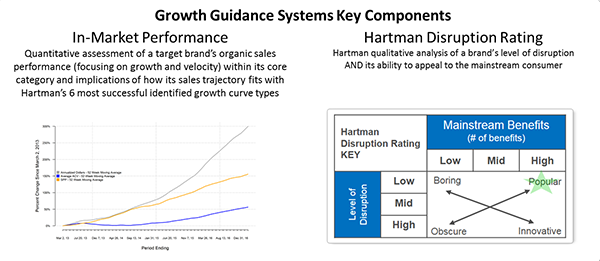Growth Solutions: What Does Your Brand Want to Be When It Grows Up?
 Campbell Soup buys Snyder’s-Lance. Danone buys WhiteWave Foods. Weetabix is taken on by Post Holdings. B&G Foods acquires Back to Nature Foods Company. Hershey’s purchases Amplify Snack Brands (which owns SkinnyPop). These are but a sampling of the robust deal-making activity in the past year, and we expect that 2018 will pick up the pace once again and deliver more than a few eye-popping headlines of its own as food and beverage companies look to M&A as the go-to growth solution strategy. But we see a fundamental challenge for executives seeking growth or pursuing M&A as the pathway to growth, evaluating whether a target company or brand’s performance is disruptive to the industry and poised for long-term growth or whether the excitement will fizzle like a short-term fad.
Campbell Soup buys Snyder’s-Lance. Danone buys WhiteWave Foods. Weetabix is taken on by Post Holdings. B&G Foods acquires Back to Nature Foods Company. Hershey’s purchases Amplify Snack Brands (which owns SkinnyPop). These are but a sampling of the robust deal-making activity in the past year, and we expect that 2018 will pick up the pace once again and deliver more than a few eye-popping headlines of its own as food and beverage companies look to M&A as the go-to growth solution strategy. But we see a fundamental challenge for executives seeking growth or pursuing M&A as the pathway to growth, evaluating whether a target company or brand’s performance is disruptive to the industry and poised for long-term growth or whether the excitement will fizzle like a short-term fad.
Thomas Jefferson said, “With great risk comes great reward.” But in today’s highly competitive marketplace, companies want to minimize the financial risk while maximizing the financial reward. So, in pursuit of growth opportunities, how does a company know which brand to pursue — in a near-term acquisition that will pay off long-term dividends?
The Hartman Group announces today the launch of the Growth Guidance Systems (GGS), a strategic metric that systemically evaluates brands in the context of true cultural disruption. It is the only one of its kind that provides a unique POV and strategic recommendations based upon real sales data combined with The Hartman Group’s long-term understanding of consumer-based demand attributes.
Hartman’s GGS helps answer the question, “What’s next after M&A?” Another way to frame this question is by asking, “What does your brand want to be when it grows up?” If you’re considering acquiring target brands that have room to grow, how do you ensure they not only get to grow up but have a long life span (aka long-term growth potential)?
The Hartman Growth Guidance Systems addresses important questions such as:
- How can I tell if a target brand is positioned for long-term growth?
- How is my target brand performing in comparison with other premium brands in the category?
- Is the target brand innovative yet also demonstrating potential to gain significant traction with the mainstream consumer?
- What kind of strategy should I focus on to increase the target brand’s growth?
Most importantly, GGS can help answer the fundamental question, “Should I pursue/invest in the brand(s) I am most interested in?”
Hartman Growth Guidance Systems: Our Proprietary Approach
Based on your target brand or company of interest, we conduct a rigorous statistical analysis of a brand within its core category alongside a qualitative analysis of the brand’s ability to disrupt the status quo from a consumer perspective. Developed from years of looking at food culture from both a data science and social science perspective, we've found that such a combination of quantitative and qualitative analyses enables answers about a target brand's In-Market Performance as well as something we call the Hartman Disruption Rating.
So how might such analyses identify opportunities trending upward? According to Shelley Balanko, Ph.D., a SVP here at The Hartman Group, there are certain food and beverage categories she believes are underserved by R&D, innovators and marketers today. "Despite the growing importance of the fresh perimeter in terms of providing revenue growth for grocery stores and satisfying consumer demand for items that support aspirations for health and culinary exploration, there are a number of refrigerated categories that still could use revitalization.” Shelley cites the following categories as examples:
- Refrigerated Meals and Sandwiches. 5-yr CAGR for refrigerated meals is negative (-1.2%), and many of offerings found in mainstream deli and prepared foods are underwhelming, making this category ideal for innovation as stores reinvest in their prepared sections in pursuit of the grocerant trend.
- Refrigerated Dips. Despite the consumer interest in all things “dippable” and spreadable and the unique innovation in the restaurant space, product variety is limited, and a number of products smack of hyper-processing and uninspired flavors.
- Refrigerated Multi-Serve Entrees. As the meal kit category takes off and consumers seek more semi-prepared solutions to the nightly dinner conundrum, these products must go beyond the highly processed, meat-driven traditional recipes that are currently present.
- Crackers. An ideal vehicle and proverbial “blank slate” for innovation that incorporates unique ingredients that deliver on wellness or culinary benefits and, depending on brand and target segment, can tap the full range of dayparts, eating occasions and mid- to upmarket positioning.
Another key component of Hartman’s Growth Guidance Systems is that the strategic recommendations can include assessment of the mainstreamability of a brand, consumer perceptions of product attributes, competitive analysis and findings on pricing, promotion and product proliferation and differentiation.
To learn how you can take advantage of growth opportunities, contact: shelley@hartman-group.com

